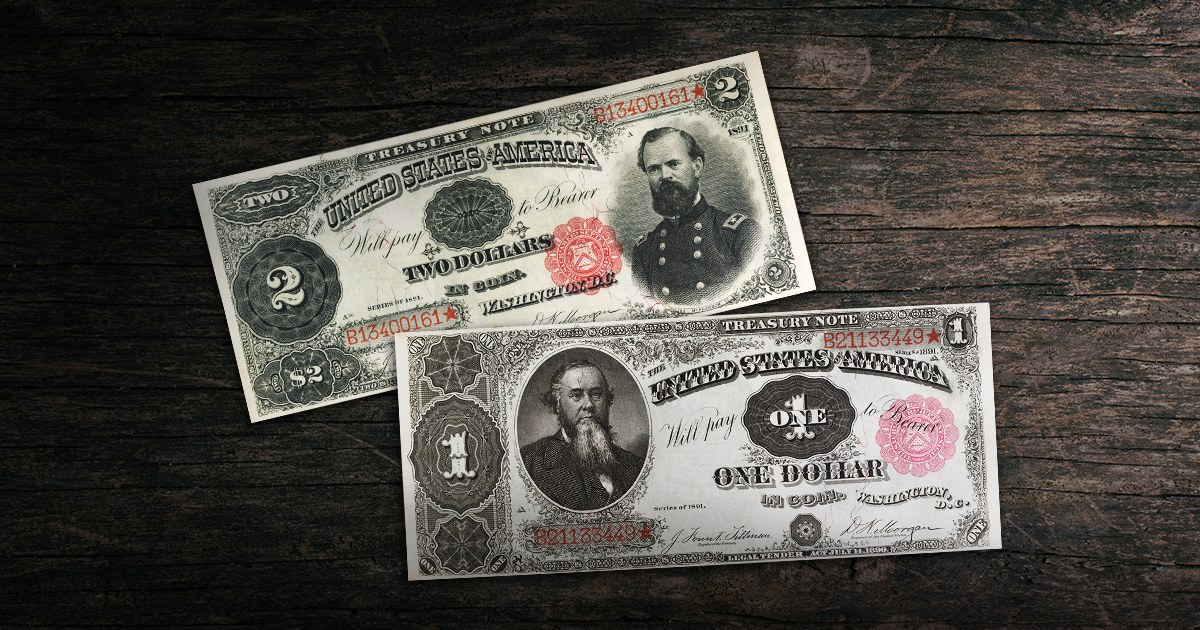
Coin Notes were a kind of promissory Treasury Note issued from 1890 until 1893 that could be redeemed for United States Mint coins under the Sherman Silver Purchase Act of 1890.
Coin Note Issues 1890-1893
Coin Notes were issued in two Series: Series 1890 and Series 1891.
The 1890 Series of Coin Notes was issued in $1 through $1,000 denominations. While the Series 1890 was issued with a $2 denomination, it was not issued with a $50 denomination. The Series 1891 Coin Notes were issued with the addition of a $50 note. While a $500 denomination was designed, it was not produced.
When the time came to redeem a coin note, the U.S. Treasury or participating bank issued either gold or silver coins.
List of Coin Notes by Series and Friedburg Number
| Denomination | Series 1890 | Series 1891 |
| $1 | Fr347, Fr#349 | Fr#351 |
| $2 | Fr#353, Fr#355 | Fr#357 |
| $5 | Fr#359, Fr# 361 | Fr#363 |
| $10 | Fr#366, Fr#368 | Fr#369 |
| $20 | Fr#372, Fr# 374 | Fr#375 |
| $50 | X | Fr#376 |
| $100 | Fr#377 | Fr# 378 |
Are Coin Notes Valuable?
As a result of their scarcity, coin notes in good condition can command a handsome price. These delicate relics serve as physical reminders of the struggles between gold and silver over the years.
Background of the Sherman Silver Purchase Act
Free silver supporters wanted the ability to have silver coined into legal tender with no limits. The free coinage of silver had been an ongoing economic policy of the United States, but opponents advocated for a more strict adherence to a fixed supply of money. Many farmers felt their debts could not be paid off because of the deflated currency of the day. They urged the federal government to inflate the economy with cheaper dollars that could pay off their debts in a reasonable time frame.
At the same time, Western mining firms had produced vast quantities of silver from their mines, and a silver supply that exceeded the demand was not profitable. These companies sought to increase the demand for silver.
Legislation Around Coin Notes
Coin notes issued between 1890 and 1891 were produced following the Sherman Silver Purchase Act of July 14, 1890. Senator John Sherman, a Republican from Ohio, acted as chairman of the Senate Finance Committee although he neither wrote the legislation nor did he agree with all of the provisions of the act. Although the legislation was titled the Silver Purchase Act of 1890 when it was passed, Senator John Sherman worked to help get the conference committee to compromise on the final version of the Act.
Senator Sherman’s name was attached to the bill, even though his support for it waned. When President Benjamin Harrison inquired about Sherman’s opinion regarding the act, Sherman’s response was merely that it was safe, and no harm would come from enacting it.
The Sherman Silver Purchase Act of 1890 was passed alongside the Tariff Act of 1890, which is also known as the McKinley Tariff. The Tariff Act of 1890 was drafted to protect domestic interests amid a competitive international market. It raised the duty on imports to an average of 50% and was an act of protectionism, an economic policy that seeks to restrict the importation of goods from other nations. Protectionism was largely supported by Republicans at the time and utilized tariffs, quotas on imports, and other regulation measures to protect domestic producers.
The Sherman Silver Purchase Act of 1890 and the Tariff Act of 1890 worked in tandem. The Sherman Silver Purchase Act mandated that the United States federal government purchase 4.5 million ounces of silver on a monthly basis and the McKinley Tariff ensured that the silver would come from a domestic source.
One of the provisions of the Sherman Silver Purchase Act was for the government to buy their silver with special issues of Treasury Coin Notes, which could be redeemed in silver or in gold.
By November 1, 1893, the Silver Purchase Act was repealed, and while no new Coin Notes were issued, existing notes remained in circulation. In March of 1900, the Gold Standard Act was passed, which mandated the US Treasury to retire and cancel Coin Notes, which were replaced by Silver Certificates. The new Silver Certificates were to be denominated at $10 or less.




